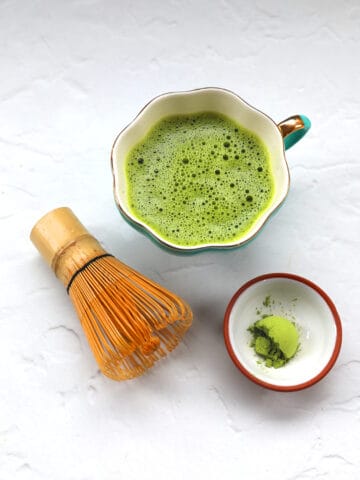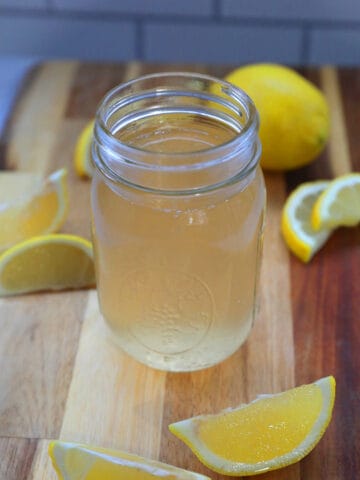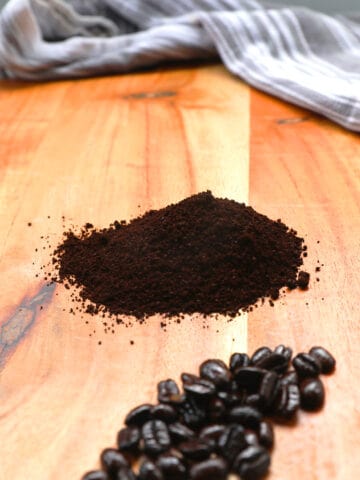One is an herbal brew. The other is derived from green tea. But these two drinks have other important distinctions. Find out the main differences between Mate vs Matcha. And learn about the purported health benefits of each.

Both matcha and mate have been growing in popularity in recent years, due in large part to their possible health advantages. And while some consider them both healthy remedies, the two drinks have some stark differences.
In this post, I’ll go over what matcha and mate are made from, what they taste like, and the potential health benefits of each of them.
Jump to:
What is matcha?
With roots in China and Japan, Matcha is finely ground, bright green powder derived from green tea leaves. It’s produced thanks to a precise growing process, which helps make them rich in antioxidants.
In the 3-4 weeks prior to harvest, the tea plants are shade-grown. This helps balance out bitter and sweet flavors produced by various compounds in the leaves. It also boosts the amount of beneficial amino acids, as well as the level of chlorophyll, which intensifies the leaves’ green color.
After harvesting, the veins and stems are removed and the leaves are ground into matcha powder.
To make matcha tea, a bamboo whisk is used to vigorously mix the powder with hot water. It can also be combined with milk or a dairy substitute to make a matcha latte.
What does matcha taste like?
Matcha is richer than regular green or black tea. It has a creamy texture and flavors that range from umami to earthy. It can also have a grassy flavor and be somewhat bitter. The quality or grade of matcha, and how much powder you use, will all affect the taste. Ceremonial-grade, high-quality matcha will often taste the best.
Matcha is also high in caffeine with about 70mg per serving. That’s more than twice the amount in a regular cup of green tea.
Health benefits of matcha

Matcha has a wide range of potential health benefits, thanks to the green tea leaves used to make it.
High in antioxidants
Matcha is rich in compounds like catechins and flavonoids which produce antioxidant properties. And antioxidants have been linked to a host of health benefits. They include:
- Neutralization of free radicals – Too many free radicals in the body can increase the risk of cancer, diabetes, heart diseases, and high blood pressure. Antioxidants help moderate these molecules which may help provide protection against these diseases.
- Vision – Antioxidants may also be able to slow some aging processes, such as poor vision due to cataracts or macular degeneration.
- Healthy skin – High levels of free radicals can prematurely age skin. By neutralizing them, antioxidants can help revitalize skin. And antioxidants like vitamin C and E help produce collagen, a primary building block of skin that helps prevent it from sagging.
Heart health
Matcha includes a particular compound called epigallocatechin gallate (EGCG). Studies have shown that it can promote cardiovascular health by helping reduce levels of bad cholesterol and limiting the build-up of plaque in coronary arteries, which can lead to heart attacks.
In one study of more than 100,000 people, researchers found that drinking green tea at least three times a week could significantly improve overall heart health. Study participants were 20 percent less likely to suffer from and die of heart disease several years after the initial study period.
May reduce cancer risks
Polyphenols in green tea have been linked to lower risks of certain types of cancer, including stomach, bladder, breast, and prostate cancer. Studies have shown that they may help combat ovarian, lung, and colorectal cancers as well.
Plus, research has associated green tea compounds with delaying the onset of cancer in some cases.
Potential weight loss
Polyphenols have also been linked to weight loss. Along with caffeine in green tea, they can help raise your body’s metabolic rate, which can lead to the more efficient burning of calories.
And simply drinking unsweetened green tea instead of other beverages that include sugar can help shed unwanted pounds.
Stress reliever
Matcha has high levels of amino acids, especially Theanine. It can reduce anxiety and stress, and promote a sense of calmness without causing drowsiness.
Studies show it may also help improve cognitive function and promote normal sleep cycles.
What is mate?

Mate, or Yerba mate, is a type of herbal drink rich in caffeine that’s made from the leaves of the plant Ilex paraguariensis, which is related to holly. It’s native to South America, particularly Argentina, Uruguay, Paraguay, and Brazil.
The tea-like drink can be prepared by steeping the dried leaves in hot water, either loose leaf or in tea bags. Traditionally, the leaves are placed in a dried out hollow gourd, then hot water is poured over them to steep. Using a filtered, metal straw known as a bombilla, the drink is then sucked from the gourd.
Mate has spiked in popularity in recent years and now people drink it to help with everything from athletic performance to improving mental sharpness.
What does yerba mate taste like?
Yerba mate is known for its strong, earthy flavor and mild bitterness, caused by the high levels of tannin in the leaves. It also has a slight sweetness to it. Often drunk on its own, mate is also sometimes combined milk, sugar, or lemon juice to enhance the flavor.
With about 80 mg of caffeine per cup, mate has about the same amount as a serving of coffee.
Health benefits of mate
Yerba mate also has a range of potential health benefits. While some are similar to those in matcha, others are unique to mate.
Increased energy
Mate’s high caffeine content is a natural stimulant that can provide a temporary energy boost when drinking it. Apart from extra energy, this can also help you stay alert and reduce fatigue.
Mental performance
The caffeine in mate also contributes to mental sharpness and memory by helping to boost some signaling functions in the brain. It also can improve mood, motivation, and productivity by stimulating levels of dopamine — a type of neurotransmitter linked to the brain’s reward system.
Lowered risk of chronic diseases
Like matcha, yerba mate is rich in antioxidants, so it may help reduce the risk of serious illnesses such as heart disease, diabetes, and certain types of cancer.
Mate is also packed with several other vitamins including vitamins A, C, and E, as well as B vitamins. These can help promote a healthy immune system, healthy vision, cell health, proper nerve function, and aid in digestion.
Weight management
Research has linked yerba mate to helping promote weight loss and curb appetite. It’s speculated that the mix of antioxidants and caffeine results in a sense of feeling full, which can help lead to weight loss.
Greater bone density
Drinking yerba mate may reduce the risk of developing osteoporosis, a weakening of bones that can lead to fractures.
One study revealed that women who drank at least a liter of mate a day had less spine and neck bone loss, suggesting a correlation between Yerba Mate consumption and bone health.
Potential harmful side effects of yerba mate and matcha
While a daily cup of mate or matcha is safe for most adults, research shows that consuming large quantities of the caffeine-rich drinks can pose potential health risks.
Studies have shown that drinking 1-2 liters of mate may increase the risk of certain cancers, especially in those who regularly consume alcohol as well.
In addition, large amounts of caffeine have been linked to:
- Pregnancy-related risks, including miscarriage and low birth weight
- Increased anxiety
- Increased risk of diabetes
- Irregular heartbeat
- High blood pressure.
Before deciding to start drinking mate or matcha regularly, check with your physician to make sure it won’t interact with other medications or supplements you may be taking, or contribute to existing health conditions.
Mate vs matcha: summary
Mate is:
- Herbal drink made from dried leaves of a plant related to holly
- Native to South America
- High caffeine levels
- Customarily drunk in communal settings with a bombilla straw out of a hollowed out gourd
- Rich in antioxidants
- Mild, earthy, flavor with mix of slight bitterness and mild sweetness
Matcha is:
- Not an herbal drink, rather a fine powder derived from green tea leaves
- Primarily from Japan
- Unique harvesting technique of the tea leaves increases beneficial amino acids and intensifies green color
- Traditional matcha tea is made by whisking the powder with hot water. Can be added with milk or non-dairy substitute to make matcha lattes
- Less caffeine than yerba mate, but more than regular green tea
- High in antioxidants
- Earthy umami flavor with mild bitterness and a smooth, creamy texture
- Ceremonial grade matcha will taste best
FAQ
Some people may be sensitive to the high amount of caffeine in yerba mate. That can make you feel dizzy or lightheaded. For others, the caffeine may provide a welcome boost of energy and mental alertness.
Drinking matcha can help keep you hydrated, which can improve your body’s digestive system and can help maintain regular bowel movements. Matcha also has been shown to increase the activity of an enzyme called pepsin found in the stomach lining. It helps break down protein so your body can more efficiently digest food.
More tea and coffee answers
Get more answers to your tea and coffee questions. Check out the posts below.






Leave a Reply